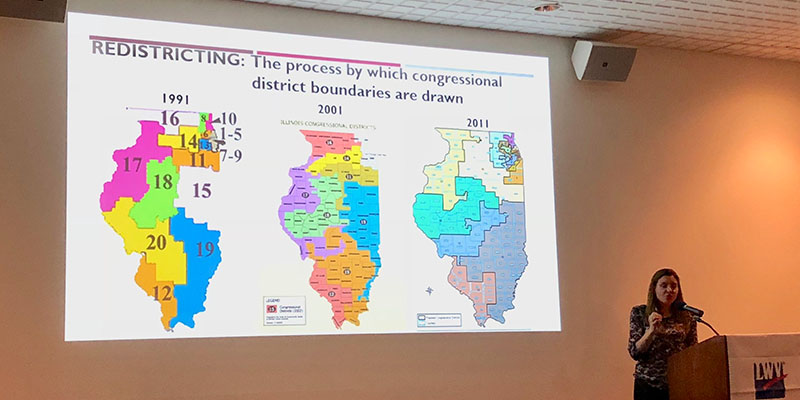
Redistricting and Voter Representation
The once-a-decade redistricting process is in full swing nationwide. The maps being drawn right now will shape communities’ congressional representation for the next decade.
On a federal level, where the balance of power is slim and partisanship so firmly entrenched as to result in government inaction, new maps could mean a seismic shift in both power and legislative agenda. In this highly partisan environment, both parties are trying to protect their positions with intentionally constructed maps.
In Illinois, as in most states, the power to draw district maps, both state and federal, lies with the legislature. This has resulted in maps that have been manipulated, or gerrymandered, so that voters are divided or combined to increase the likelihood of one party to win future elections.
Gerrymandering is voter suppression.
LWVIL fights racial and partisan gerrymandering, advocates for legislation to ensure fair maps are drawn by an independent commission, and strongly encourages citizen involvement in map-drawing. Equitable representation is the foundation of our democracy.
The Freedom to Vote Act will ban gerrymandering. However, once candidates have begun filing for office, it will be very difficult to change the maps for elections in 2022. In some states, candidates begin filing this November. This is why the Freedom to Vote Act must be passed soon.
Federal Legislative Maps
As states begin proposing their new congressional maps, the highly partisan nature of current national politics is clearly evident.
Among the 16 states that have proposed maps to date, the number of districts leaning solidly to one party or the other is on the rise. Maps for Iowa, Ohio, Oregon, Texas, and Washington show ten additional districts leaning toward the Democrats. Maps for Iowa, Georgia, Maryland, and Texas, show five additional districts leaning toward the Republicans.
Firmly entrenched partisanship is also clearly seen in the dwindling numbers of highly competitive districts. Maps for Colorado, Michigan and Ohio show only four additional highly competitive districts. Maps for Texas, Georgia, Iowa and Oregon show ten fewer highly competitive districts.
Predicted party leanings for proposed congressional maps released by each state will be watched closely by both parties going into the 2022 elections.
Illinois, which lost one congressional seat with the Census, is holding public hearings for resident input on congressional district maps October 7–15. However, the final maps will be drawn by the Democrat-controlled Illinois General Assembly (ILGA), and it is predicted the maps will be drawn so as to solidify at least two additional seats for the Democrats, while eliminating one for the Republicans.
Illinois’ State Legislative Maps
District maps for state legislative offices were required by the state Constitution to be completed by June 30, 2021. In order to meet the deadline, the Illinois General Assembly (ILGA) drew maps for state legislative districts using population estimates from the US Census Bureau’s American Community Survey (ACS). These maps were signed into law by Governor Pritzker on June 4, 2021.
The census data released in August revealed inaccuracies in the state district maps. In some cases, variances between district populations were as high as 30%, which is far greater than the 10% allowed by the US Constitution. As a result, the ILGA called a special session and revised the maps. The new maps were passed along party lines and signed by Governor Pritzker on September 24, 2021. However, the maps are being questioned by Republicans and various minority groups, and legal challenges are expected.
LWVIL continues to advocate for legislation to guarantee public input into the map drawing process.
Independent redistricting commissions and bi-partisan redistricting commissions that allow voters to be directly involved in the map-drawing process are in effect in Arizona, California, Colorado, Michigan, and Virginia. California’s 2011 state legislative maps maintained the existing partisan balance, but resulted in the election of 16 additional minority legislators in 2012. Iowa, Maine, and Vermont have advisory commissions that can propose redistricting plans, although the final maps remain in the hands of the legislature.